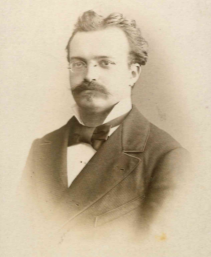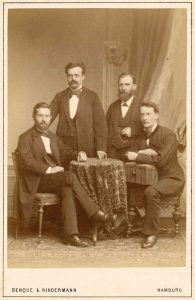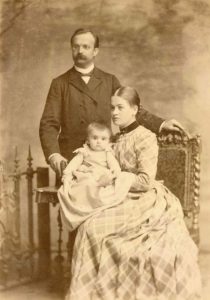Ernst Hartwig (1851–1923)
Hier finden Sie die deutsche Textfassung.
In January 1886, Ernst Hartwig took up his appointment as director of the observatory to be built in Bamberg. After three years of planning and construction works, the observatory could be opened in October 1889. He remained director until 1923.

Hartwig during his time in Strasbourg. Image courtesy of Luise Bräuer.
Ernst Hartwig was born in Frankfurt am Main on 14 January 1851, and went to school there and in Nuremberg, where he graduated from Melanchton Gymnasium in 1869. Afterwards, he studied mathematics, physics, and astronomy at FAU Erlangen-Nuremberg and in Leipzig, Göttingen, and Munich. In 1874 he moved to Strasbourg, where a new observatory had been set up after the city had become German in the course of the Franco-Prussian war 1870–71. At first trainee at the observatory and teacher at the local Lyceum, he became assistant of August Winnecke (1835–1897), the director of the observatory and eminent authority for observations at the heliometer. In 1880, he received a doctorate for his work on the libration of the moon and continued at the Imperial Observatory in Strasbourg until 1884.

The German Venus expedition to Bahia Blanca in Hamburg. From left to right: Bruno Peter, Ernst Hartwig, Heinrich Mayer, Walter Wislicenus. Image courtesy of Luise Bräuer
This time was interrupted by his leading an astronomical expedition to Bahia Blanca (Argentina) from September 1882 to February 1883. Purpose of this expedition was the observation of the transit of Venus in front of the Sun. At that time, these observations provided the most exact method for determining the astronomical unit, if taken at different locations on earth. Since these transits are rare events (one each in 2012, 2004, 1882, 1874, 1769, 1761,…), major efforts have been made to fund expeditions, and in 1882 four German expeditions were sent to North and South America.
The situation in Strasbourg had become difficult after Winnecke was (again) struck by mental illness. Early in 1882 he had to withdraw from the observatory for good, and Hartwig was unhappy with his working conditions there. Accordingly, he embraced a new position as observer in Dorpat (Russia) starting 1884. During this time, he discovered the first supernova of modern times, S Andromedae on 30 May 1885.

Ernst Hartwig with his wife Nanette and daughter. Image courtesy of Luise Bräuer
Prof. Hugo von Seeliger (Munich), who supervised the foundation process of the new observatory in Bamberg together with Prof. Heinrich Bruns (Leipzig), nominated Hartwig to become its director. This job offered him the much longed for independence in his scientific work, and he arranged for construction and instrumentation of the new observatory. The main focus of his scientific work thereafter was on variable stars, carrying on the legacy of August Winnecke. Unfortunately, publishing the results was very difficult for him, because Dr. Karl Remeis had allocated too little money for printing costs. Beyond his immediate scientific work he followed the will of Remeis and engaged in outreach activities to the general public.
In his personal life things seem to have gone well after he came to Bamberg. From his marriage with Nannette Müller sprung two daughters, Emma and Lina. Hartwig was actively observing into his old age and died on 3 May 1923.
Further reading:



